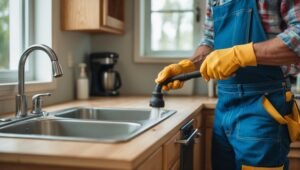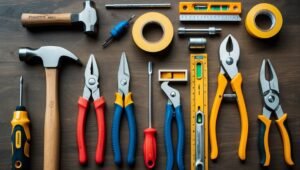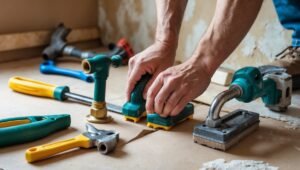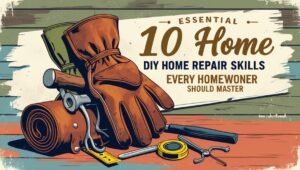
How a Simple DIY Fix Saved My Weekend (And My Budget
There’s nothing quite like the satisfaction of fixing something yourself. Last weekend, I faced a plumbing issue that I couldn’t ignore. My kitchen sink leaked,
Homeownership comes with a lot of responsibilities—chief among them, maintaining and repairing your property. While calling in a professional may seem like the easiest solution when something goes wrong, the costs can quickly add up. Whether it’s fixing a leaky faucet, replacing a worn-out door lock, or repairing a broken appliance, homeowners can do many common home repairs themselves, saving hundreds or even thousands of dollars each year. In this blog, we’ll explore how DIY home repairs can help you take control of your home’s upkeep, keep your budget intact, and give you the satisfaction of knowing that you’ve solved the problem yourself.

1. Understanding the True Cost of Home Repairs
The first step in understanding how DIY repairs can save you money recognizes just how expensive hiring a professional can be. The average cost of hiring a plumber for a simple job, like fixing a leaky faucet, can range from $100 to $300, depending on your location. Similarly, electricians and handymen can charge upwards of $50 to $100 per hour. When you factor in call-out fees, labor, and materials, small household repairs can quickly become a costly endeavor.
While some repairs definitely require a professional, homeowners with the right tools, instructions and a little confidence can easily handle many routine tasks around the house. By learning to tackle some of these repairs yourself, you can save money on service calls and invest it elsewhere, such as upgrading your home or building your DIY tool collection.
2. Common DIY Home Repairs Homeowners Can Tackle
Some of the most common household repairs that homeowners can tackle include:
Fixing Leaky Faucets: A leaky faucet may seem like a minor issue, but it can waste gallons of water and inflate your utility bills. Replacing the washer or cartridge inside the faucet is a simple fix that can save you money in the long run.
Patching Holes in walls: Whether it’s from a nail, screw, or accidental impact, small holes in the drywall are easy to repair with spackle and a putty knife. A fresh coat of paint, and your wall will look as good as new.
Replacing Door Handles and Locks: If your door handles or locks are broken, don’t call a locksmith. You can purchase replacement hardware at most home improvement stores and follow a simple installation guide to do it yourself.
Unclogging Drains: Clogged drains are common in kitchens and bathrooms, but before you call a plumber, try a few DIY methods like using a plunger, a drain snake, or a natural cleaning solution made of baking soda and vinegar.
Changing Air Filters: Regularly changing your HVAC filters not only ensures that your system is running efficiently, but it also prevents costly repairs down the line. Filters are inexpensive and easy to replace.
These simple repairs may seem minor, but when you add up the cost of having to call a professional for each one, you’ll quickly see how much you can save by taking care of these tasks yourself.
3. Choosing the Right Tools for DIY Home Repairs
The key to successfully completing any DIY repair is having the right tools. While it might tempt to rely on makeshift solutions like a butter knife or duct tape, investing in a basic set of high-quality tools will make repairs easier, faster, and more effective.
Start by building a tool kit with essentials like a hammer, screwdriver set, pliers, utility knife, measuring tape, and level. As you take on more DIY projects, you may need additional tools, such as a drill, saw, or caulk gun. Having a comprehensive set of tools on hand will not only save you time during repairs but also save you money in the long run, as you won’t need to rent or borrow tools from others.

4. Step-by-Step Guides and Resources
Once you have the right tools, the next step is knowing how to use them. The internet has made it easier than ever to find step-by-step guides and tutorials on almost any home repair project. Websites like FixItSmartly.com offer detailed DIY guides for everything, from plumbing to electrical repairs. These resources are perfect for homeowners who are looking for easy-to-follow instructions without the need to hire a professional.
Consider checking out our DIY Home Repair Mastery guide, which provides expert tips on handling repairs around your home with confidence. Whether you’re a beginner or an experienced DIYer, our resources offer clear instructions and troubleshooting advice to ensure your repairs are successful.
5. When to Call a Professional
While many DIY projects are simple and manageable, a professional should always handle some repairs. For example, electrical work, major plumbing issues, and structural problems require specialized knowledge and expertise. If you ever feel unsure about the safety or complexity of a repair, it’s best to call in a pro to avoid causing further damage or creating a hazard.
6. How DIY Repairs Can Enhance Your Home’s Value
Not only do DIY repairs save you money, but they can also increase your home’s value. Simple improvements like replacing outdated light fixtures, freshening up the paint, or fixing a broken fence can enhance your home’s curb appeal and make it more attractive to potential buyers. By taking care of small repairs, you ensure that your home is well-maintained and in great shape, which could pay off when it’s time to sell.
Finally
DIY home repairs are a great way to save money, learn new skills, and take pride in the maintenance of your home. With the right tools, a little knowledge, and the resources available online, homeowners can tackle a wide range of repairs with no expensive professionals. From fixing leaky faucets to patching holes in the wall, the satisfaction of completing a successful repair can’t be beat—and the savings add up fast!

Relevant Links:
Explore our DIY Home Repair Mastery guide for more expert tips and step-by-step instructions.
Check out the Ultimate Home Maintenance Checklist Bundle to stay on top of your home repairs and prevent costly future fixes.
Share this article:
– read more –

There’s nothing quite like the satisfaction of fixing something yourself. Last weekend, I faced a plumbing issue that I couldn’t ignore. My kitchen sink leaked,

Owning a car comes with its own set of responsibilities. Regular maintenance can prevent costly repairs down the line, and knowing how to handle minor

Homeownership comes with its fair share of maintenance and repair tasks. While some repairs are best left to professionals, there are plenty of simple fixes

As a homeowner, taking on small repairs around the house can seem intimidating, especially if you’ve never done them before. However, with the right mindset,

As a homeowner, it’s important to have a basic understanding of home repairs. Whether you want to save money on costly service calls or simply

Homeownership comes with a lot of responsibilities—chief among them, maintaining and repairing your property. While calling in a professional may seem like the easiest solution